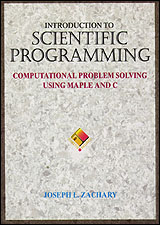Counting Loops Tutorial
In this tutorial you will experiment with using C while
statements to implement counting loops. You will be using some
example programs in this tutorial. You can use your Web browser to
view or download them as you prefer.
The general form of a while loop is
while (<condition>) {
<statements>
}
where <condition> stands for a Boolean expression that is
either true or false, and <statements> stands for one or more
statements.
When C encounters a while loop, it follows these steps.
- The <condition> is evaluated. If it is false, C skips
ahead to the next statement following the while loop.
Otherwise, it proceeds to step 2.
- The <statements> are evaluated in order. When they
have been evaluated, C returns to step 1 above.
The body of a while loop can be evaluated zero or more times. If
the condition is initially false, the body of the loop will not be
evaluated at all.
Although every while loop has the same general form,
while loops can be used to serve a variety of different
purposes. A common form of loop is the counting loop, in which
the loop repeats a fixed number of times.
Download count1.c and read it into an
Emacs buffer. Compile and run the program. The program will prompt
you for an integer; try entering 10 the first time, 5 the second time,
and -5 the third time. Notice that the program prints out all of the
integers from 1 up to the one that you entered. If the integer that
you enter is smaller than 1, no integers are printed out.
The counting loop contained in count1.c is
printf("The integers from 1 up to %d are:\n", limit);
i = 1;
while (i <= limit) {
printf("%d ", i);
i = i + 1;
}
printf("\n");
A counting loop typically uses a variable to count from some initial
value to some final value. This variable is often called the
index variable. In this example, the index variable is
i.
There are usually six components to a counting loop:
A counting loop with always have an index initialization statement, an
index control expression, one or more body statements, and an index
update statement. It will not always have setup statements or final
statements.
- Modify count1.c so that it allows the user to specify
both the starting point and the stopping point.
- Modify count1.c so that it prints only the even numbers
less than or equal to limit.
Download count2.c and read it into an
Emacs buffer. This program is divided into a factorial
function, which takes an integer n as its parameter and
returns n!, and a main function, which exercises
factorial. We will focus on the factorial function.
The counting loop that appears in factorial is
product = 1;
i = 1;
while (i <= n) {
product = product * i;
i = i + 1;
}
Recall that  . This loop works by
accumlating the product of the first n integers into the
variable product, which begins with a value of 1. Each time
through the loop, the current value of i is multiplied into
product. During the course of the loop, i counts up
from 1 to n.
. This loop works by
accumlating the product of the first n integers into the
variable product, which begins with a value of 1. Each time
through the loop, the current value of i is multiplied into
product. During the course of the loop, i counts up
from 1 to n.
In the previous section we identified the six components of a counting
loop. See if you can classify the components of the loop above along
those lines.
Click here for the answer
- Modify count2.c so that it calculates the sum of
the integers from 1 to n instead of their product.
- Modify count2.c so that it works by counting
down from n to 1 instead of counting up from 1 to n.
